Wetting and Spreading of AgCuTi on Selective Laser-Melted Ti-6Al-4V
Abstract
1. Introduction
2. Methods
3. Results and Discussion
3.1. Wetting Spreading Process and the Kinetics Analysis
3.1.1. Influence of Temperature on the Wetting Process
3.1.2. Effect of Dwell Time on the Wetting Process
3.2. Microstructure Analysis of Wetting Interface
3.3. Comparison with AgCuTi/Rolled TC4 System
4. Conclusions
- Temperature has a great influence on the AgCuTi/SLMed TC4 system. With the increase of brazing temperature, the final wetting area of AgCuTi filler on SLMed TC4 gradually increases. Precursor film appears at the front edge of the triple line at temperatures of 850 °C and 900 °C. As the temperature increases, the spreading of the precursor film becomes faster, especially at 950 °C.
- The wetting process of AgCuTi filler metal on SLMed TC4 is similar at 850 °C and 900 °C and can be divided into four stages: (i) initial spreading stage; (ii) rapid spreading stage; (iii) the precursor film spreading stage; (iv) the stage of approaching balance. However, at 950 °C, the increase of temperature promotes the wetting of AgCuTi on SLMed TC4 substrate, which can also be divided into four stages: (i) initial spreading stage; (ii) rapid spreading stage; (iii) slow spreading and the precursor film spreading stage, when two processes take place at the same time; (iv) the stage of approaching balance.
- Holding time slightly promotes the spreading process. Liquid filler metal spreads rapidly during the heating stage and slowly during the dwell process. The prolongation of holding time promotes the slow spreading stage.
- The kinetics of wetting of the AgCuTi/SLMed TC4 system can be analyzed by Rn ~ t model. The n value of the rapid spreading stage is 1, which belongs to the reaction-limited wetting. The n values of the precursor film spreading stage are 0.44, 0.4 and 0.35, respectively. Temperature plays an important role in the precursor film spreading process.
- The wetting spreading of AgCuTi/rolled TC4 system is similar to that of the AgCuTi/SLMed TC4 system in terms of phenomena and wetting kinetics.
Author Contributions
Funding
Institutional Review Board Statement
Informed Consent Statement
Data Availability Statement
Conflicts of Interest
References
- Huang, J. Study of Microstructure and Properties of TC4 Alloy by Selective Laser Melting. Master’s Thesis, Nanchang Hangkong University, Nanchang, China, June 2018. [Google Scholar]
- Su, Y.; Wu, B.; Wang, X. Research on Further Application of Additive Manufacturing Technology on Aviation Equipment. Aeronaut. Manuf. Technol. 2016, 12, 42–48. [Google Scholar]
- Yan, X.; Ruan, X. Application and development of additive manufacturing technology in aeroengine. Aeronaut. Manuf. Technol. 2016, 2, 70–75. [Google Scholar]
- Gurrappa, I. Characterization of titanium alloy Ti-6A1-4V for chemical, marine and industrial applications. Mater. Charact. 2003, 51, 131–139. [Google Scholar] [CrossRef]
- Vastola, G.; Zhang, G.; Pei, Q.-X.; Zhang, Y. Modeling the Microstructure Evolution during Additive Manufacturing of Ti6Al4V: A Comparison between Electron Beam Melting and Selective Laser Melting. JOM 2016, 68, 1370–1375. [Google Scholar] [CrossRef]
- Do, D.-K.; Li, P. The effect of laser energy input on the microstructure, physical and mechanical properties of Ti-6Al-4V alloys by selective laser melting. Virtual Phys. Prototyp. 2016, 11, 41–47. [Google Scholar] [CrossRef]
- Xia, C.; Zhao, M.; Sun, W.; Li, H.; Liu, P. Microstructure and Properties of 3D Printed Inconel 718 Joint Brazed with BNi-2 Amorphous Filler Metal. Mater. Res. 2019, 22. [Google Scholar] [CrossRef]
- Prashanth, K.; Damodaram, R.; Scudino, S.; Wang, Z.; Rao, K.P.; Eckert, J. Friction welding of Al-12Si parts produced by selective laser melting. Mater. Des. 2014, 57, 632–637. [Google Scholar] [CrossRef]
- Prashanth, K.; Damodaram, R.; Maity, T.; Wang, P.; Eckert, J. Friction welding of selective laser melted Ti6Al4V parts. Mater. Sci. Eng. A 2017, 704, 66–71. [Google Scholar] [CrossRef]
- Nahmany, M.; Rosenthal, I.; Benishti, I.; Frage, N.; Stern, A. Electron beam welding of AlSi10Mg workpieces produced by selected laser melting additive manufacturing technology. Addit. Manuf. 2015, 8, 63–70. [Google Scholar] [CrossRef]
- Tillmann, W.; Henning, T.; Wojarski, L. Vacuum brazing of 316L stainless steel based on additively manufactured and conventional material grades. IOP conference series. Mater. Sci. Eng. 2018, 373, 12023. [Google Scholar]
- Yu, H.; Li, F.; Yang, J.; Shao, J.; Wang, Z.; Zeng, X. Investigation on laser welding of selective laser melted Ti-6Al-4V parts: Weldability, microstructure and mechanical properties. Mater. Sci. Eng. A 2018, 712, 20–27. [Google Scholar] [CrossRef]
- Akselsen, O.-M. Advances in brazing of ceramics. J. Mater. Sci. 1992, 27, 1989–2000. [Google Scholar] [CrossRef]
- Saiz, E.; Cannon, R.-M.; Tomsia, A.-P. Reactive spreading: Adsorption, ridging and compound formation. Acta Mater. 2000, 48, 4449–4462. [Google Scholar] [CrossRef]
- Saiz, E.; Tomsia, A.-P.; Suganuma, K. Wetting and strength issues at Al/α-alumina interfaces. J. Eur. Ceram. Soc. 2003, 23, 2787–2796. [Google Scholar] [CrossRef][Green Version]
- Villanueva, W.; Boettinger, W.; McFadden, G.; Warren, J. A diffuse-interface model of reactive wetting with intermetallic formation. Acta Mater. 2012, 60, 3799–3814. [Google Scholar] [CrossRef]
- Yin, L.; Murray, B.-T.; Singler, T.-J. Dissolutive wetting in the Bi-Sn system. Acta Mater. 2006, 54, 3561–3574. [Google Scholar] [CrossRef]
- Yu, X.; Yang, J.; Yan, M.; Hu, X.W.; Li, Y.L. Kinetics of wetting and spreading of AgCu filler metal over Ti–6Al–4V substrates. J. Mater. Sci. 2016, 51, 10960–10969. [Google Scholar] [CrossRef]
- Liu, J.; Liu, G.-P.; Ouyang, H.; Li, Y.-L.; Yan, M.; Pecht, M. Wetting Kinetics and Microstructure Analysis of BNi2 Filler Metal over Selective Laser Melted Ti-6Al-4V Substrate. Materials 2020, 13, 4666. [Google Scholar] [CrossRef]
- Huang, X.; Lei, M.; Li, X.; Li, Y. Effects of surface roughness on the TiAl/AgCu/TiAl brazing quality. Mater. Sci. Technol. 2019, 27, 1–7. [Google Scholar]
- Li, Y.; Liu, W.; Sekulic, D.-P.; He, P. Reactive wetting of AgCuTi filler metal on the TiAl-based alloy substrate. Appl. Surf. Sci. 2012, 259, 343–348. [Google Scholar] [CrossRef]
- Liu, G.; Li, Y.; Long, W.; Hu, X.; Cao, J.; Yan, M. Wetting kinetics and spreading phenomena of the precursor film and bulk liquid in the AgCuTi/TC4 system. J. Alloy. Compd. 2019, 802, 345–354. [Google Scholar] [CrossRef]
- Zhao, H.; Wang, H.Q.; Sekulic, D.P.; Qian, Y.Y. Spreading Kinetics of Liquid Solders over an Intermetallic Solid Surface. Part 1: Eutectic Lead Solder. J. Electron. Mater. 2009, 38, 1838–1845. [Google Scholar] [CrossRef]
- Kozlova, O.; Voytovych, R.; Protsenko, P.; Eustathopoulos, N. Non-reactive versus dissolutive wetting of Ag–Cu alloys on Cu substrates. J. Mater. Sci. 2010, 45, 2099–2105. [Google Scholar] [CrossRef]
- Tillmann, W.; Pfeiffer, J.; Sievers, N.; Boettcher, K. Analyses of the spreading kinetics of AgCuTi melts on silicon carbide below 900°C, using a large-chamber SEM. Colloids Surf. A Physicochem. Eng. Asp. 2015, 468, 167–173. [Google Scholar] [CrossRef]
- Landry, K.; Kalogeropoulou, S.; Eustathopoulos, N. Wettability of carbon by aluminum and aluminum alloys. Mater. Sci. Eng. A 1998, 254, 99–111. [Google Scholar] [CrossRef]
- Mortensen, A.; Drevet, B.; Eustathopoulos, N. Kinetics of diffusion-limited spreading of sessile drops in reactive wetting. Scr. Mater. 1997, 36, 645–651. [Google Scholar] [CrossRef]
- Landry, K.; Eustathopoulos, N. Dynamics of wetting in reactive metal/ceramic systems: Linear spreading. Acta Mater. 1996, 44, 3923–3932. [Google Scholar] [CrossRef]
- Li, Y.; Wang, Z.; Li, X.; Lei, M. Effect of temperature and substrate surface roughness on wetting behavior and interfacial structure between Sn–35Bi–1Ag solder and Cu substrate. J. Mater. Sci. Mater. Electron. 2020, 31, 4224–4236. [Google Scholar] [CrossRef]
- Xian, A.-P. Precursor film of tin-based active solder wetting on ceramics. J. Mater. Sci. 1993, 28, 1019–1030. [Google Scholar] [CrossRef]
- Qla, B.; Feng, Q.-B.; Ran, S.-C. Characteristics of precursor film in the wetting of Zr-based alloys on ZrC substrate at 1253K. Thin Solid Films 2014, 558, 231–236. [Google Scholar]
- Lin, Q.; Jin, P.; Cao, R.; Chen, J. Reactive wetting of low carbon steel by Al 4043 and 6061 alloys at 600–750 °C. Surf. Coat. Technol. 2016, 302, 166–172. [Google Scholar] [CrossRef]
- Krakhmalev, P.; Fredriksson, G.; Yadroitsava, I.; Kazantseva, N.; du Plessis, A.; Yadroitsev, I. Deformation Behavior and Microstructure of Ti6Al4V Manufactured by SLM. Phys. Procedia 2016, 83, 778–788. [Google Scholar] [CrossRef]


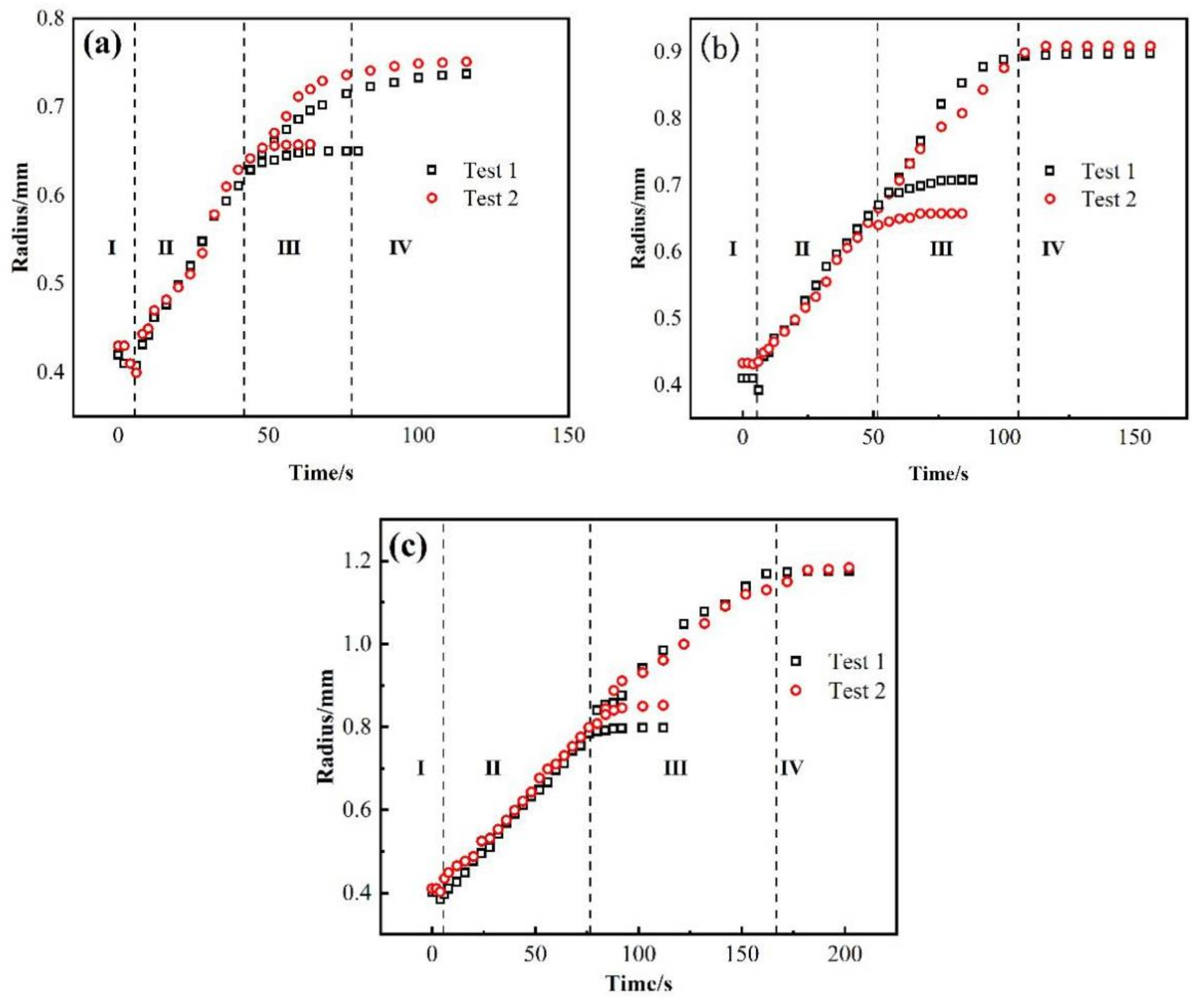
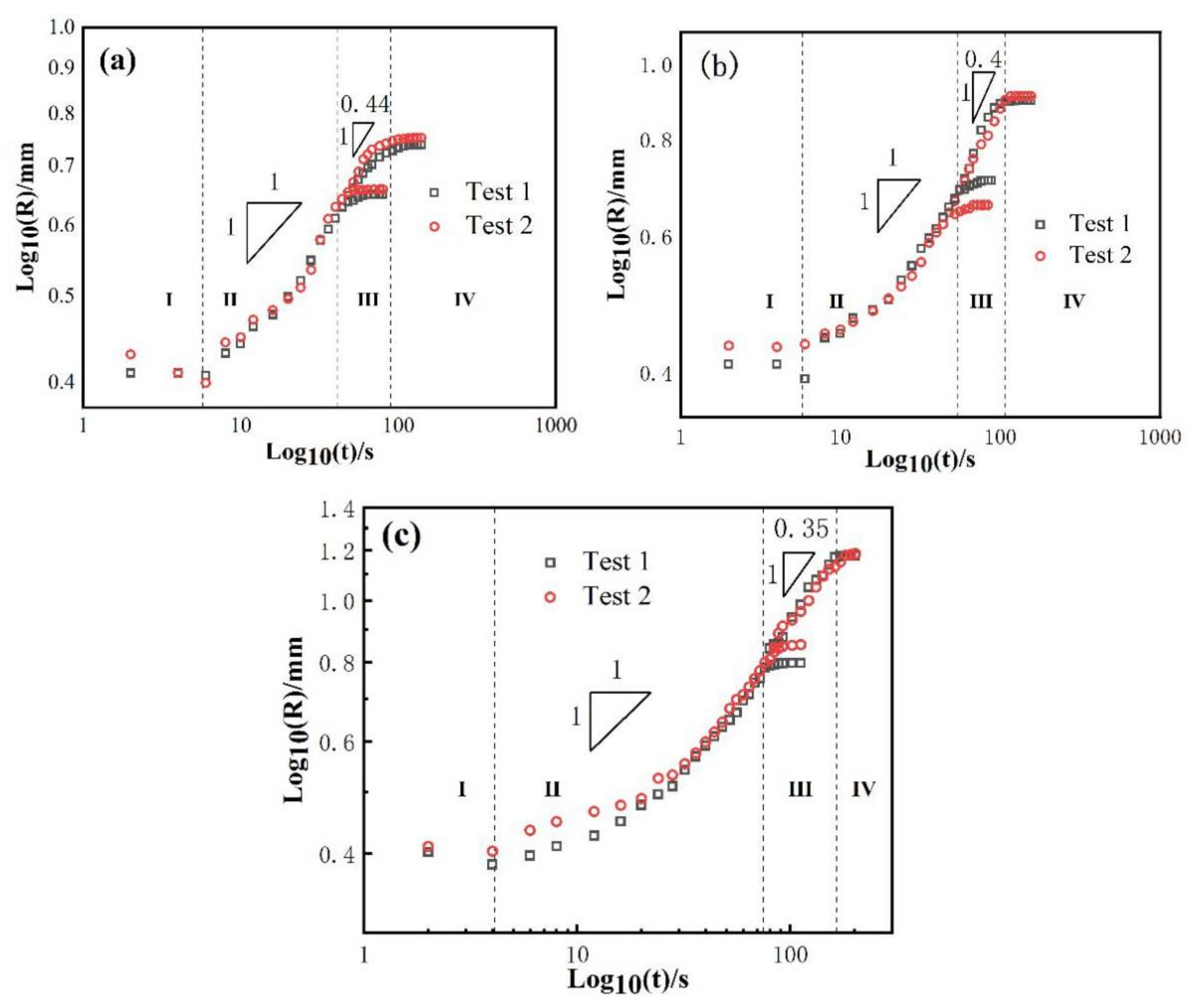
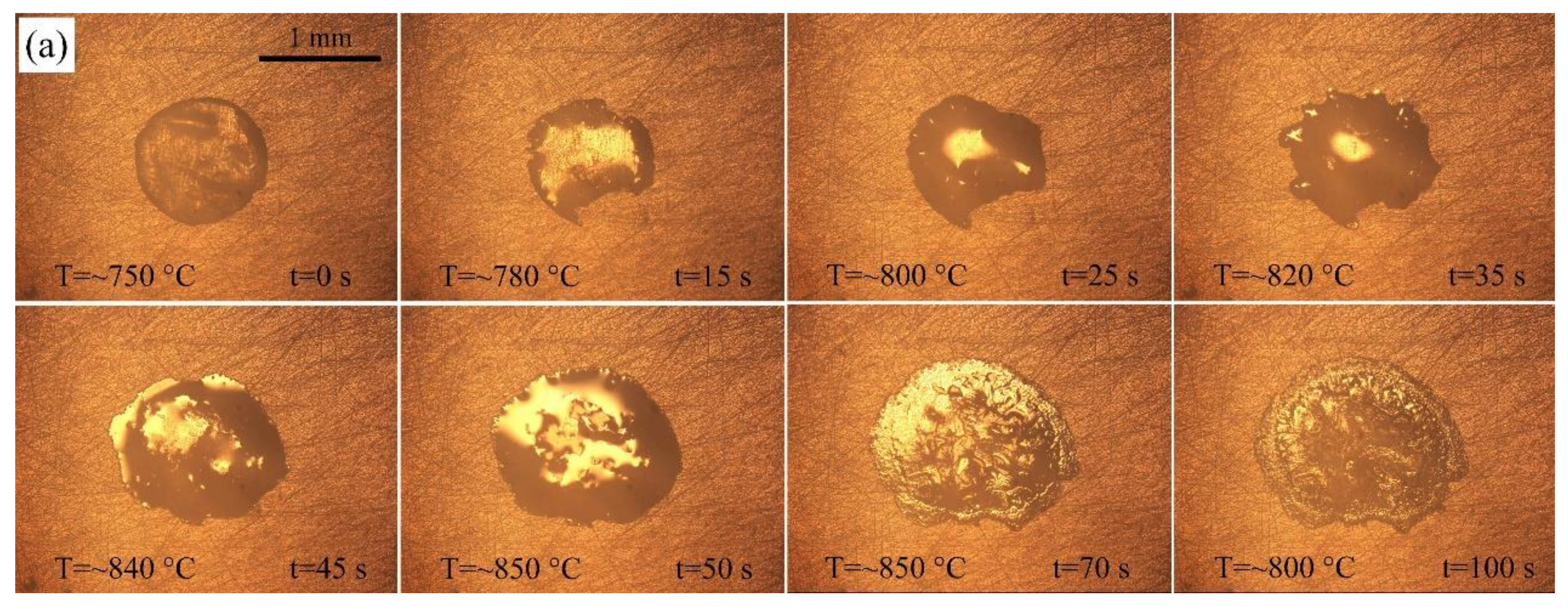
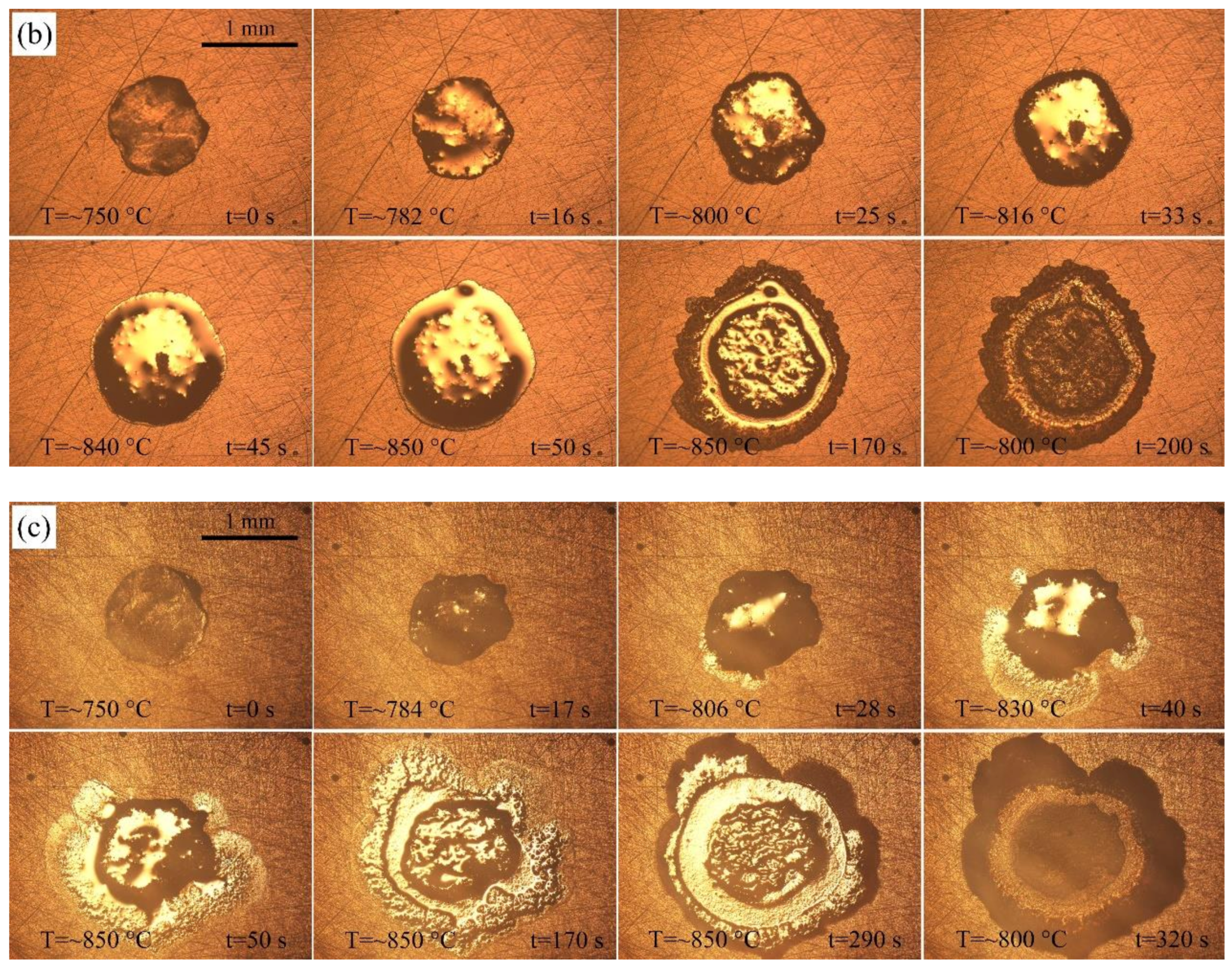
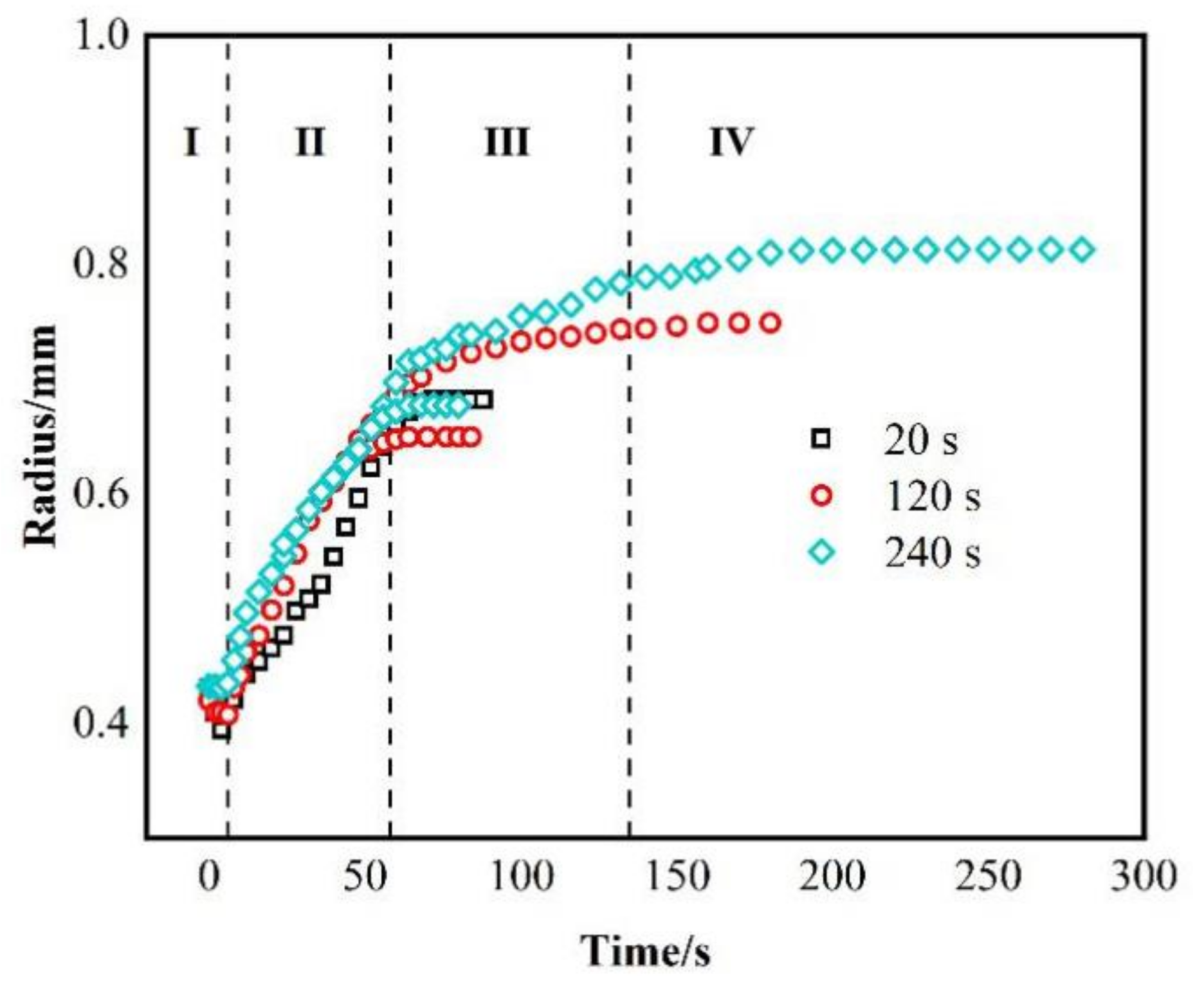



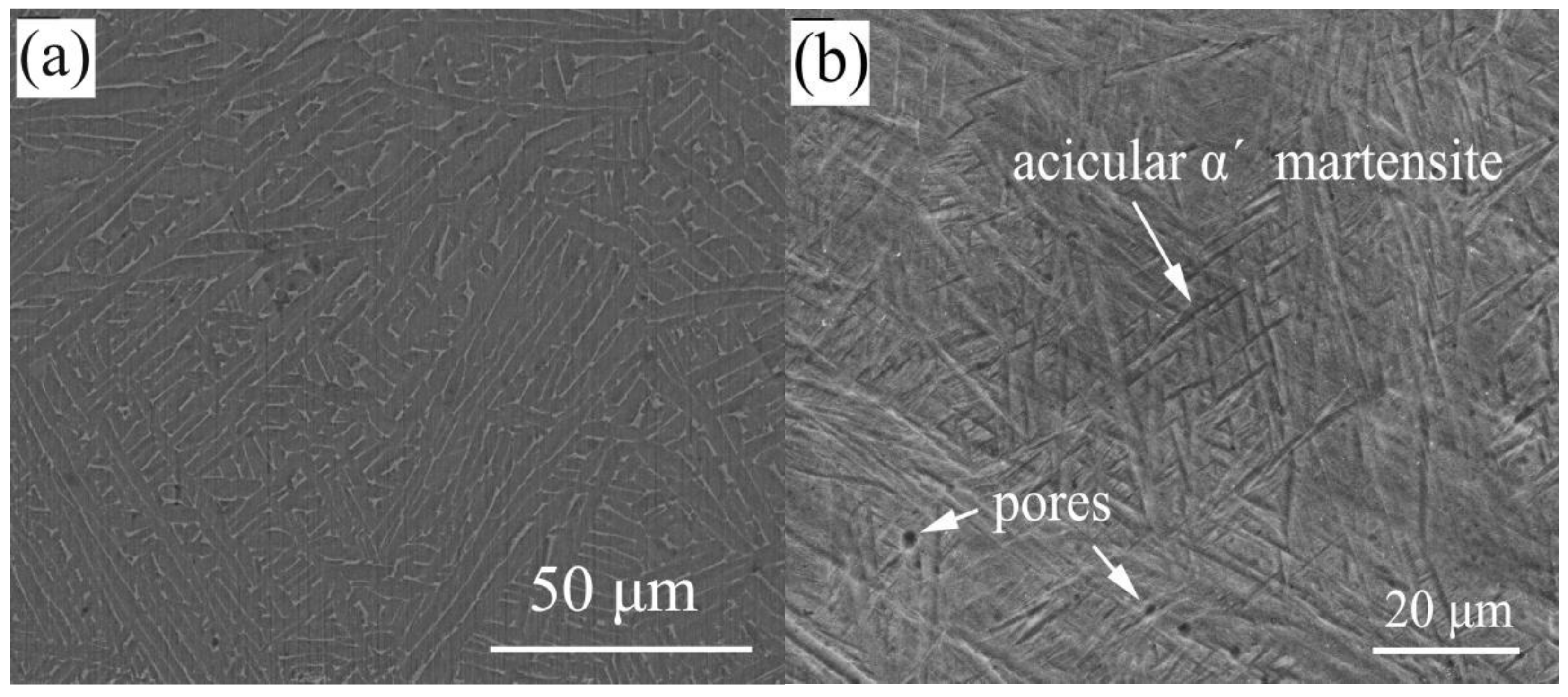
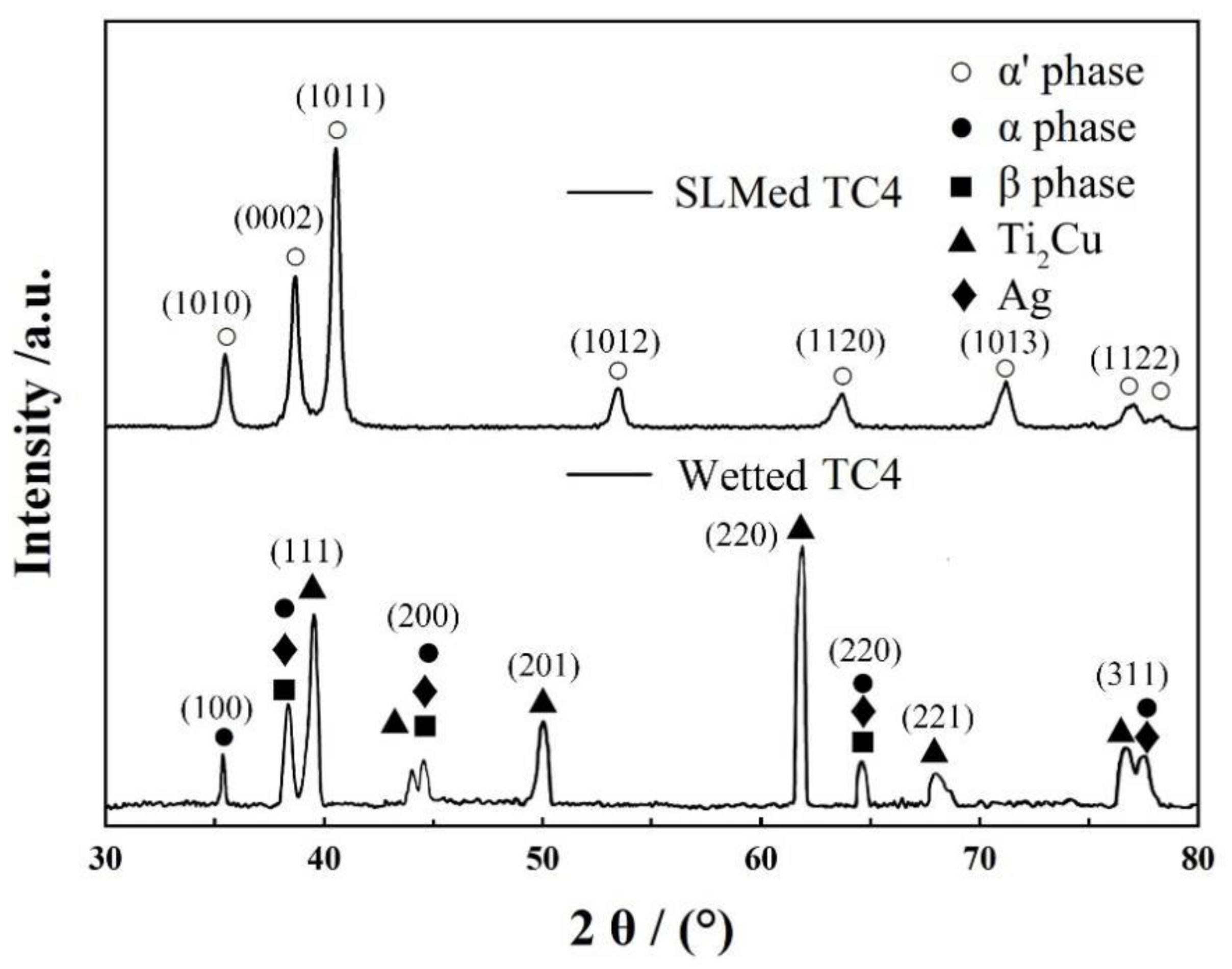
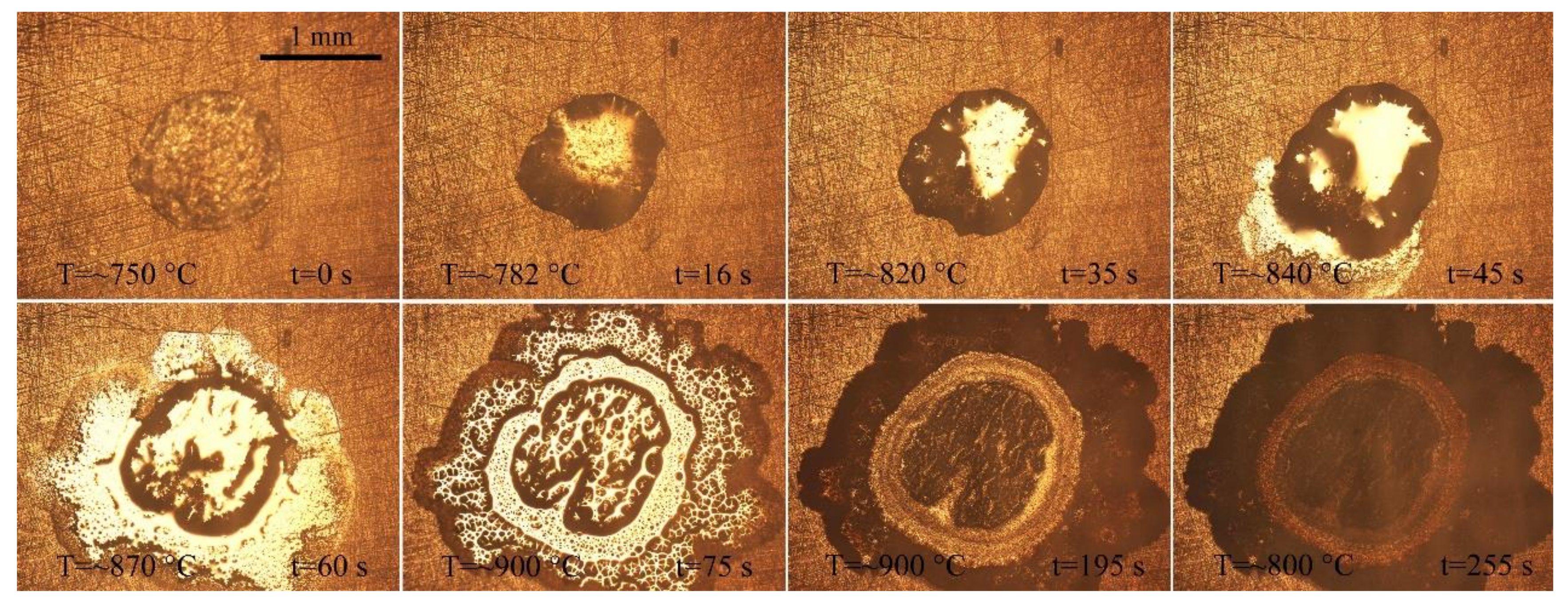

| Process Parameters | Values |
|---|---|
| Laser energy density (VED) | 69.5 J·mm−3 |
| Laser power (P) | 275 W |
| Laser scanning speed (v) | 1100 mm·s−1 |
| Printing layer thickness (h) | 0.03 mm |
| Overlap spacing (l) | 0.12 mm |
| wt.% | |||||||
|---|---|---|---|---|---|---|---|
| Al | V | Fe | C | N | O | H | Ti |
| 5.5~6.8 | 3.5~4.5 | ≤0.30 | ≤0.10 | ≤0.05 | ≤0.20 | ≤0.015 | Margin |
| Points | Main Elements (at.%) | Possible Phase | ||||
|---|---|---|---|---|---|---|
| Ag | Cu | Ti | Al | V | ||
| A | 97.66 | 2.34 | - | - | - | Ag(ss) |
| B | 8.37 | 14.91 | 71.02 | 5.7 | - | Ti2Cu + Ti(ss) |
| C | 3.42 | 7.56 | 75.02 | 9.23 | 4.68 | Ti2Cu + Ti(ss) |
| D | 2.48 | 8.89 | 74.82 | 10.08 | 3.73 | Ti2Cu + Ti(ss) |
| E | 9.46 | 18.28 | 66.54 | 4.39 | 1.33 | Ti2Cu + Ti(ss) |
| F | - | - | 85.96 | 11.21 | 2.83 | α-Ti |
| G | 95.98 | 0.51 | 3.51 | - | - | Ag(ss) |
| H | 4.56 | 2.11 | 82.34 | 10.99 | - | Ti(ss) |
| I | 1.25 | 2.63 | 80.19 | 13.02 | 3.01 | α-Ti |
| J | - | 1.99 | 82.57 | 12.65 | 2.79 | β-Ti |
Publisher’s Note: MDPI stays neutral with regard to jurisdictional claims in published maps and institutional affiliations. |
© 2021 by the authors. Licensee MDPI, Basel, Switzerland. This article is an open access article distributed under the terms and conditions of the Creative Commons Attribution (CC BY) license (https://creativecommons.org/licenses/by/4.0/).
Share and Cite
Hao, L.; Liu, J.; Li, Y. Wetting and Spreading of AgCuTi on Selective Laser-Melted Ti-6Al-4V. Materials 2021, 14, 4804. https://doi.org/10.3390/ma14174804
Hao L, Liu J, Li Y. Wetting and Spreading of AgCuTi on Selective Laser-Melted Ti-6Al-4V. Materials. 2021; 14(17):4804. https://doi.org/10.3390/ma14174804
Chicago/Turabian StyleHao, Lujing, Jiankun Liu, and Yulong Li. 2021. "Wetting and Spreading of AgCuTi on Selective Laser-Melted Ti-6Al-4V" Materials 14, no. 17: 4804. https://doi.org/10.3390/ma14174804
APA StyleHao, L., Liu, J., & Li, Y. (2021). Wetting and Spreading of AgCuTi on Selective Laser-Melted Ti-6Al-4V. Materials, 14(17), 4804. https://doi.org/10.3390/ma14174804






